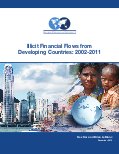 Crime, corruption, and tax evasion drained US$946.7 billion from the developing world in 2011, up more than 13.7 percent from 2010. These findings by Washington based Think Tank Global Financial Integrity, which peg cumulative illicit financial outflows from developing countries at US$5.9 trillion between 2002 and 2011 are part of a new study. "As the world economy sputters along in the wake of the global financial crisis, the illicit underworld is thriving – siphoning more and more money from developing countries each year," says GFI President Raymond Baker.
Crime, corruption, and tax evasion drained US$946.7 billion from the developing world in 2011, up more than 13.7 percent from 2010. These findings by Washington based Think Tank Global Financial Integrity, which peg cumulative illicit financial outflows from developing countries at US$5.9 trillion between 2002 and 2011 are part of a new study. "As the world economy sputters along in the wake of the global financial crisis, the illicit underworld is thriving – siphoning more and more money from developing countries each year," says GFI President Raymond Baker.
December 19, 2013 | Global Financial Integrity
Illicit Financial Outflows from Developing World Nearly $6 Trillion in Decade between 2002 and 2011
The report Illicit Financial Flows from Developing Countries: 2002-2011 is GFI’s 2013 annual update on the amount of money flowing out of developing economies as a result of crime, corruption and tax evasion, and it is the first of GFI’s reports to include data for the year 2011.
GFI President Raymond Baker criticizes: “Anonymous shell companies, tax haven secrecy, and trade-based money laundering techniques drained nearly a trillion dollars from the world’s poorest in 2011, at a time when rich and poor nations alike are struggling to spur economic growth. While global momentum has been building over the past year to curtail this problem, more must be done. This study should serve as a wake-up call to world leaders: the time to act is now.”
Methodology
Authored by GFI Chief Economist Dev Kar and GFI Junior Economist Brian LeBlanc, the study is the first by GFI to incorporate trade data on re-exports from Hong Kong and the first to integrate bilateral trade data for those countries which report it—making this report the most accurate analysis of illicit financial outflows produced by GFI to date.
“The estimates provided by our new methodology are still likely to be extremely conservative as they do not include trade misinvoicing in services, same-invoice trade misinvoicing, hawala transactions, and dealings conducted in bulk cash,” explained Dr. Kar, who served as a Senior Economist at the International Monetary Fund before joining GFI in January 2008. “This means that much of the proceeds of drug trafficking, human smuggling, and other criminal activities, which are often settled in cash, are not included in these estimates.”
Findings
The US$946.7 billion of illicit outflows lost in 2011 is a 13.7 percent uptick from 2010—which saw developing countries hemorrhage US$832.4 billion—and a dramatic increase from 2002, when illicit outflows totaled just US$270.3 billion. The study estimates the developing world lost a total of US$5.9 trillion over the decade spanning 2002 through 2011.
“It’s extremely troubling to note just how fast illicit flows are growing,” stated Dr. Kar. “Over the past decade, illicit outflows from developing countries increased by 10.2 percent each year in real terms—significantly outpacing GDP growth. This underscores the urgency with which policymakers should address illicit financial flows.”
Moreover, the US$946.7 billion that flowed illicitly out of developing countries in 2011 was approximately 10 times the US$93.8 billion of net official development assistance (ODA) [XLS | 49 KB] that went into these specific 150 developing countries that year. This means that for every US$1 in economic development assistance going into a developing country, roughly US$10 of capital are lost via illicit outflows.
“Illicit financial flows have major consequences for developing economies,” explained Mr. LeBlanc, the co-author of the report. “Poor countries hemorrhaged nearly a trillion dollars from their economies in 2011 that could have been invested in local businesses, healthcare, education, or infrastructure. This is nearly a trillion dollars that could have been used to help pull people out of poverty and save lives. Without concrete action, the drain on the developing world is only going to grow larger.”
Dr. Kar and Mr. LeBlanc’s research tracks the amount of illegal capital flowing out of 150 different developing countries over the 10-year period from 2002 through 2011, and it ranks the countries by the volume of illicit outflows.
Sub-Saharan Africa Suffers Biggest Relative Problem
The new report is also the first GFI study to examine illicit financial outflows on a regional basis as a percent of GDP, determining that Sub-Saharan Africa—whose illicit outflows averaged 5.7 percent of GDP each year—suffers the most due to such outflows. Globally, annual illicit financial outflows averaged 4.0 percent of GDP.
Download the full report here.
